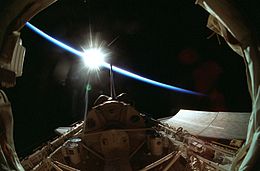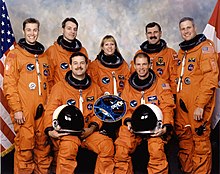This article has multiple issues. Please help improve it or discuss these issues on the talk page. (Learn how and when to remove these messages)
|
 Spacelab Module LM2 in Columbia's payload bay, serving as the Neurolab | |
| Names | Space Transportation System-90 |
|---|---|
| Mission type | Bioscience research |
| Operator | NASA |
| COSPAR ID | 1998-022A |
| SATCAT no. | 25297 |
| Mission duration | 15 days, 21 hours, 50 minutes, 58 seconds |
| Distance travelled | 10,000,000 kilometres (6,200,000 mi) |
| Spacecraft properties | |
| Spacecraft | Space Shuttle Columbia |
| Landing mass | 105,462 kilograms (232,504 lb) |
| Payload mass | 10,788 kilograms (23,783 lb) |
| Crew | |
| Crew size | 7 |
| Members | |
| Start of mission | |
| Launch date | 17 April 1998 18:19 UTC |
| Launch site | Kennedy, LC-39B |
| End of mission | |
| Landing date | 3 May 1998 16:09 UTC |
| Landing site | Kennedy, SLF Runway 33 |
| Orbital parameters | |
| Reference system | Geocentric |
| Regime | Low Earth |
| Perigee altitude | 247 kilometres (153 mi) |
| Apogee altitude | 274 kilometres (170 mi) |
| Inclination | 39.0 degrees |
| Period | 89.7 min |

 Left to right – Front row: Altman, Searfoss; Back row: Pawelczyk, Linnehan, Hire, Williams, Buckey | |
STS-90 was a 1998 Space Shuttle mission flown by the Space Shuttle Columbia. The 16-day mission marked the last flight of the European Space Agency's Spacelab laboratory module,[1] which had first flown on Columbia on STS-9, and was also the last daytime landing for Columbia.